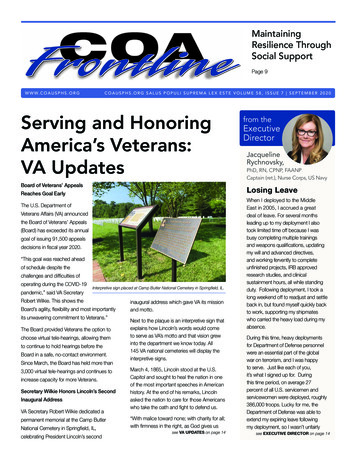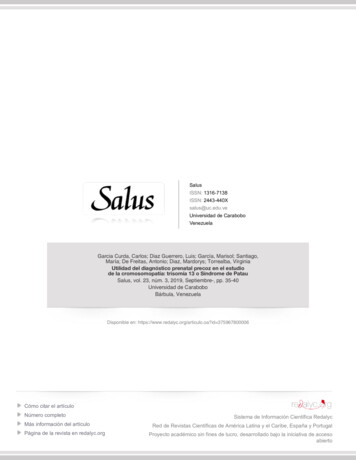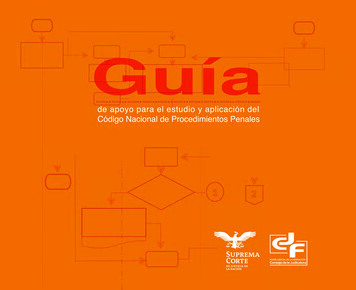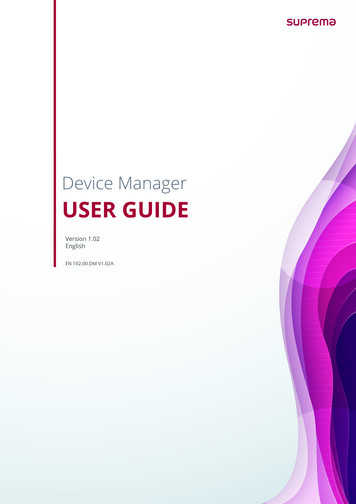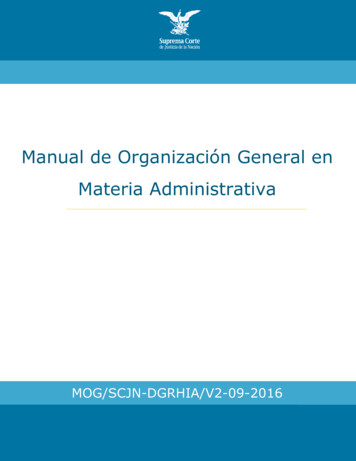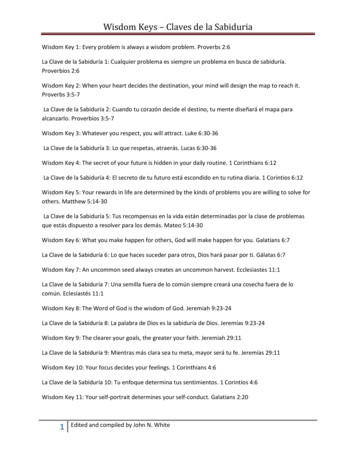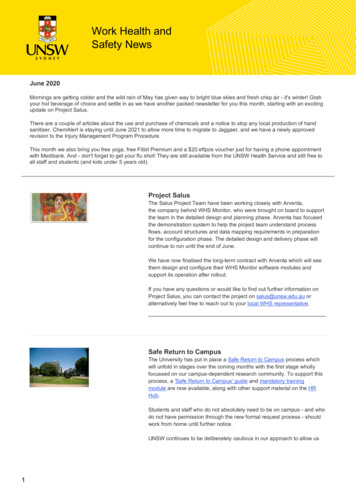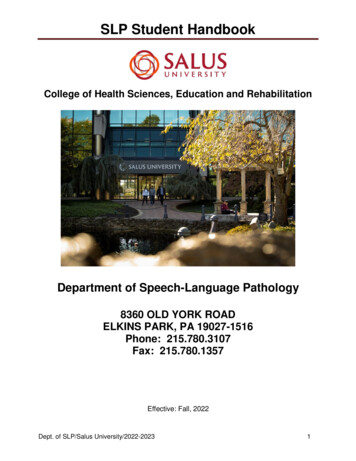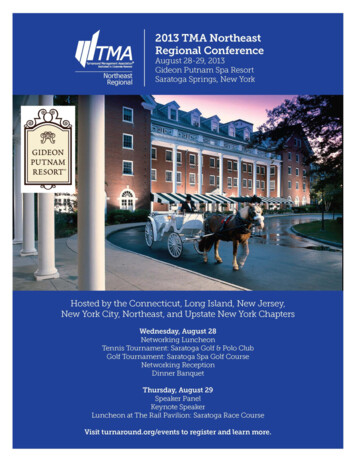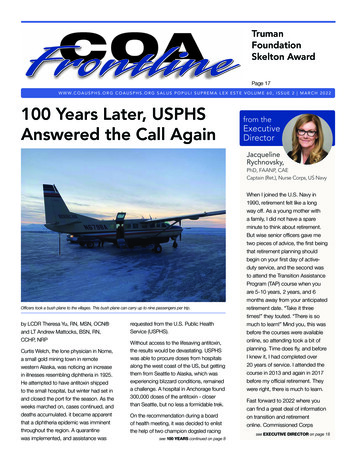
Transcription
TrumanFoundationSkelton AwardPage 17W W W. C O A U S P H S . O R G C O A U S P H S . O R G S A L U S P O P U L I S U P R E M A L E X E S T E V O L U M E 6 0 , I S S U E 2 M A R C H 2 0 2 2 .100 Years Later, USPHSAnswered the Call Againfrom theExecutiveDirectorJacquelineRychnovsky,PhD, FAANP, CAECaptain (Ret.), Nurse Corps, US NavyWhen I joined the U.S. Navy in1990, retirement felt like a longway off. As a young mother witha family, I did not have a spareminute to think about retirement.But wise senior officers gave metwo pieces of advice, the first beingthat retirement planning shouldbegin on your first day of activeduty service, and the second wasto attend the Transition AssistanceProgram (TAP) course when youare 5-10 years, 2 years, and 6months away from your anticipatedOfficers took a bush plane to the villages. This bush plane can carry up to nine passengers per trip.retirement date. “Take it threetimes!” they touted. “There is soby LCDR Theresa Yu, RN, MSN, OCN and LT Andrew Mattocks, BSN, RN,CCHP, NRPCurtis Welch, the lone physician in Nome,a small gold mining town in remotewestern Alaska, was noticing an increasein illnesses resembling diphtheria in 1925.He attempted to have antitoxin shippedto the small hospital, but winter had set inand closed the port for the season. As theweeks marched on, cases continued, anddeaths accumulated. it became apparentthat a diphtheria epidemic was imminentthroughout the region. A quarantinewas implemented, and assistance wasrequested from the U.S. Public HealthService (USPHS).much to learn!” Mind you, this wasWithout access to the lifesaving antitoxin,the results would be devastating. USPHSwas able to procure doses from hospitalsalong the west coast of the US, but gettingthem from Seattle to Alaska, which wasexperiencing blizzard conditions, remaineda challenge. A hospital in Anchorage found300,000 doses of the antitoxin - closerthan Seattle, but no less a formidable trek.online, so attending took a bit ofOn the recommendation during a boardof health meeting, it was decided to enlistthe help of two champion dogsled racingon transition and retirementsee 100 YEARS continued on page 8before the courses were availableplanning. Time does fly, and beforeI knew it, I had completed over20 years of service. I attended thecourse in 2013 and again in 2017before my official retirement. Theywere right, there is much to learn.Fast forward to 2022 where youcan find a great deal of informationonline. Commissioned Corpssee EXECUTIVE DIRECTOR on page 18
COA MemberBenefitsCapitol Hill RepresentationEfforts on Capitol Hill continually supportall Commissioned Corps officers – active,former, reserve, and retiredLocal RepresentationCOA Local Branches provide venuesfor meeting fellow officers and a forumfor the discussion of issues within theCommissioned CorpsNewsletterNewsletter reports on monthly activitiesand items of interest about the Corpsand COARibbonAuthorized to be worn on the PHSuniform by members in good standingwhen attending COA functionsInsurance ProgramsLow-cost insurance programs that maycontinue as long as your membership inCOA remains currentLegislative UpdateLegislative Advocacy Goalsfor the Second Session of the117th Congressby CAPT Alan Echt, USPHS (Ret.),Legislative Affairs Committee ChairYour Legislative Affairs CommitteeUSF Online ProgramsDiscounted degree and certificateprograms like PhD, DrPH, MPH, MSPH,and MHANYMC Online MPH50 percent discount for the online MPHand certificate programsScholarship Programsrecently voted on goals to pursue in thisCongressional Session. Those prioritiesare:1. A permanent resolution to the dilemmathat has occurred in the past two yearsbecause of the 60-day limit on leavecarryover in 42 U.S.C. § 210–1.2. Amending the definition of “coveredCollege scholarships for children andspouses of COA members and highschool studentsThe Ohio State UniversityIn-state tuition for graduate nursing andcertification programsmember” in the Military Lending Act, 10U.S.C. §987.3. Amending the Family and MedicalLeave Act, 29 U.S.C Chapter 28,to allow family members of USPHSofficers to take leave under the act tocare for active duty and veteran USPHSofficers.that USPHS officers are paid duringIATIONCOMMISSIO4. Seeking a legislative solution to ensureFFICERSASCSONOEDOFTH.NCE USPHS Igovernment shutdowns.5. Amending the Alexander LofgrenVeterans in Parks law to include theUSPHS Commissioned Corps in theNational Park Service’s free passprogram.6. Finding a legislative fix to ensureparental leave parity with the ArmedForces.7. Amending veterans’ preference infederal hiring in 5 U.S.C. to includeveterans of the USPHS.Your inability to take annual leavebecause of the deployment tempo duethe pandemic compelled COA to goto Congress two years in a row to askfor legislative language in each year’sContinuing Resolution to ensure that youwould not lose accrued annual leavein excess of 60 days. It is time for apermanent fix.Members frequently contact COA tocomplain that they have been deniedaccess to incentives aimed at the military,such as free deluxe credit cards and retaildiscounts, because the Military LendingAct database used by financial servicescompanies does not include the USPHS.We hope to fix that oversight.The Family and Medical Leave Act (FMLA)permits the spouse, son, daughter, parent,or next of kin of a covered servicememberto take servicemember family leave tocare for the servicemember. We wouldlike Congress to amend the definition ofsee LEGISLATIVE continued on page 22
Digging Deeper: Understanding How EmployersProtect Worker Safety, Health and Well-Beingby Anna Mayor, USF College of Public HealthThe article originally appeared in the USF College of Public HealthNews on January 24, 2022. Reprinted with permission of USF.Little is known about how employers implement guidelines thatprotect and promote the safety, health, and well-being of theirworkers, according to USF College of Public Health doctoralstudent Heidi Hudson.Hudson, who is pursuing a Doctor of Public Health degree inadvanced practice leadership in public health, is lead author onthe study, “An Exploratory, Qualitative Study of How OrganizationsImplement the Hierarchy of Controls Applied to Total WorkerHealth ,” published in the International Journal of EnvironmentalResearch and Public Health. The article is part of a special issueon Worker Safety, Health, and Well-being in the USA.Hudson, who is a health scientist in the Division of ScienceIntegration within the National Institute for Occupational Safetyand Health (NIOSH), part of the Centers for Disease Control andPrevention (CDC), has been with NIOSH since 2004. She alsobecame a Commissioned Officer of the U.S. Public Health Servicein 2008.The study provides insight into how the principles of the Hierarchyof Controls Applied to NIOSH Total Worker Health (TWH HoC)guidelines have been implemented among employers featured as‘Promising Practices for TWH.’CDR Heidi Hudson, MPH (Photo courtesy of Heidi Hudson)Hudson found that an organization’s culture and readiness forimplementation had a significant impact on the implementationof approaches that protect worker safety, health, and well-being.Findings also indicated that the characteristics of the interventions,such as their advantages and adaptability, were importantconsiderations for successful implementation within organizations.Hudson said this study “addresses an important gap in the field ofTWH by providing a preliminary and practical understanding intohow early adopter organizations of various sizes and sectors haveThe TWH HoC emphasizes organizational-level interventions toprotect workers’ safety, health, and well-being, according to theCDC. Some examples include restricting tobacco use, providinghealthier lunch options, reducing work-related stress, and offeringhealthy movement policies to reduce sitting for long periods.applied principles consistent with the TWH approach.”Hudson, who focused on work-related issues of fatigue, stress,sedentary work, and tobacco control, identified how and whatimpacted the implementation of TWH HoC guidelines amongorganizations to address those work issues.experience opportunities or improved health or reductions in health“I hope my research will inspire professionals in public health tobetter understand how work can positively and negatively influencehealth and well-being. Not just through using the workplace as apoint to access people to educate, but to recognize that workerswhile they are working,” Hudson said.see SAFETY continued on page 21“The TWH HoC is a conceptual model designed to aid employersand other professionals interested in implementing workplacesafety and health programs aligned with TWH approaches,”Hudson said. “After reviewing articles that featured organizationsapplying TWH principles, we selected organizations to discusshow they implemented TWH approaches. Overall, we conductedseven in-depth organizational interviews with thirteen keyinformants.”“The finding that stood out the most to me was that employmentorganizations appear to be prevention-focused and seek toaddress working conditions that threaten the safety, health andwell-being of their workforce,” Hudson said.Hierarchy of Controls Applied to NIOSH Total Worker Health. (Source: NIOSH)March 2022 Page 3
Centerpiece of a Redesigned Federal Health Systemby RADM Steve Solomon, MD, FACP,The legislation is far-reaching and coverspublic health system carries an impliedFIDSA, USPHS (Ret.)numerous areas of the Federal response.threat to the Corps. We are proud of theHowever, in none of the 52 sectionsCorps’ history and never more so thancovering those 205 pages is there anyin consideration of service during themention of the U.S. Assistant Secretary ofCOVID pandemic. But to ensure the futureHealth, U.S. Surgeon General, U.S. Publicof the Corps, much less to advocate forHealth Service, or the Commissionedits growth and greater independence,Corps of the USPHS.we need to be specific in showing theThe public health system in the UnitedStates, especially at the Federal level, isgoing to be significantly restructured. Howthis restructuring will be designed andimplemented is impossible to predict. Adriving force for reorganizing public healthwill begin with draft legislation, now beingI find that worrisome. Some may arguetremendous value the Corps will bring to arestructured public health system.written in the Senate.that not being mentioned means thatThis proposed legislation, titled PrepareCongress is pleased with the performanceAmong the critical problems that the Taskof the Corps and its leaders. MyForce investigating the Federal pandemicconcern is that there has always beenresponse will highlight are at least three forfor and Respond to Existing Viruses,Emerging New Threats, and PandemicsAct (PREVENT Pandemics Act), calls for,among many other things in its 205 draftpages, a bipartisan Task Force, likelyand continues to be a profound lackof recognition, appreciation and evenawareness of the Commissioned Corpswithin both the Executive and Legislativepatterned after the 9/11 Commission, tobranches of government. This has been“examine and assess” the U.S. responsean ongoing problem since at least theto COVID-19. Other sections addressJohnson and Nixon presidencies. Virtuallystate and local readiness, improvingthe only component of the Executiveemergency responses, public healthBranch that routinely mentions the Corpsdata, revitalizing the workforce, and muchis the Office of Management and Budget,more. The legislation addresses changesat both CDC and FDA. Co-sponsor Sen.Richard Burr, the ranking Republicanwhich has tried to downsize or eveneliminate the Corps from the President’sbudget in every administration over theon the Senate Health, Education, Laborpast 50 years.and Pensions Committee, has saidOver those decades, COA and the Corps’“[O]ne of the biggest challenges weleaders, and a small number of allies inface is addressing the systemic andCongress have been able to preservecultural failures of the CDC under twothe Corps from extinction. However, anyAdministrations.”significant reorganization of the FederalPage 4 March 2022which a strengthened and larger USPHSCommissioned Corps will offer elegantsolutions.The first is the structural problem ofwhat has been called a disjointedpublic health system. Problems withinter-agency collaboration, especiallyaround policy-setting, decision-makingand messaging, are a focus of manycritics. A recent article in The Hill byauthors from the Harvard T.H. ChanSchool of Public Health -start-here) suggestedthe Federal public health structurebe reorganized using an approachsimilar to that taken by Congress in thesee PRESIDENT continued on page 18
Retirement Tax ChangesCAPT Alan Echt, USPHS (Ret.)March, when our thoughts turn to the spring and we file incometax returns. Commissioned Corps retirees in some states cancelebrate this year, while others should write their state legislatorsand ask, “Where’s the love?” The key words are “armed forces”and “uniformed services.” Here are the tax changes for retirementpay that I’ve heard about this year. I am not an attorney or anaccountant. Consult with a tax professional.WinnersArizona: Arizona expanded a 3500 partial exemption ofuniformed service retirement pay to a full exemption and madeit retroactive, “ for taxable years beginning from and afterDecember 31, 2020,” You can read the bill here - 8S.pdf. The relevantlanguage is on page 79, lines 17-25.Minnesota: As a result of a letter from COA and subsequentcorrespondence via email, the Minnesota Department of Revenue(MNDOR) determined that retired USPHS officers and theirsurviving spouses who participate in the Survivor Benefit Plan areeligible for the military retirement pay subtraction in MN Stat §290.0132 (2020), Subd. 21. The MNDOR website was updatedthe “Bailey Settlement” (see Directive PD-99-1, “Qualifying FederalRetirement Systems”). The fiscal note for S105 enate/PDF/SFN0105v4.pdf)states that, “Certain military retirement income is already exemptfrom State personal income tax under the ‘Bailey Settlement.’ Thebill makes additional military retirement income exempt.” I think thismeans that North Carolina created an age-based tax exemption,where older USPHS retirees can claim the exemption under Bailey,and younger retirees’ pensions will be fully taxed. As I write this, Ito reflect that change. A retired COA member in Minnesotaam waiting for a response from the NC Department of Revenue.contacted the MNDOR and subsequently wrote me that retireesCheck with your preparer.there can amend past returns, if they qualify for the subtractionand are within the statute of limitations. This is one of those timesto work with a tax professional.Nebraska: Nebraska also expanded their partial exemption forretired members of the uniformed services. They made it a fullexemption beginning in tax year 2022. See NE Stat §77-2716,paragraphs 15 (a) through (c).LosersNew Mexico: As this article went to press, the New Mexicolegislature passed HB 163, a bill that includes an armed forcesretirement income tax deduction of 10,000 in the 2022 taxyear, 20,000 in the 2023 tax year, and 30,000 starting with the2024 tax year and ending after the 2026 tax year. The Governor isexpected to sign the bill.North Carolina: A new law provides a full deduction of armedUtah: Gov. Spencer J. Cox signed Senate Bill 11 on March 11,2021. The new law tax-exempts armed forces retirement incomein Utah. You can read the bill here - https://le.utah.gov/ 2021/bills/static/SB0011.html. The relevant text begins on line 127.New Mexico, North Carolina, and Utah join Connecticut (seeCT Gen Stat § 12-701 (2020)), Indiana (see IN Code § 6-3-2-4(2020)), Iowa (see IA Code § 422.7 (2021)), Maine (see 36 ME RevStat § 5122 (2020)), Michigan (see MI Comp L § 206.30 (2020)),Missouri (see MO Rev Stat § 143.121 (2021)), New Jersey (see NJRev Stat § 54A:6-26 (2020)), and North Dakota (see 2021 NorthDakota Century Code Title 57 Taxation Chapter 57-38 Income Tax)in exempting armed forces retirement income but taxing USPHSretirees. Some of those states allow deductions of other pensionincome, which may be subject to limitations. Check with your taxprofessional.forces retirement income. You can read the bill here - https://In the S105v7.pdf. TheStates to watch in 2022 for military pension income tax legislationrelevant text is on page 590, beginning at “Eliminate Tax on Militaryinclude California, Delaware, Kentucky, South Carolina, andPension Income.” Previously, USPHS retirees in North CarolinaVermont. Remember, your legislators are elected to serve you.could deduct their pension income if they had at least five years ofAs I wrote this article, only five states fully tax military retirementcreditable service before August 12, 1989 under what is known asincome: California, Montana, Rhode Island, Vermont, and Virginia.March 2022 Page 5
FFICERSASIATIONCOMMISSIOOEDCSONOFTHBoard of Directors.NCE USPHS IMentoring Our Newest Officersby CDR Kristie Purdy, MS, RDN/LD,BC-ADM, CDCESChair-Elect, COA Board of DirectorsMany of us are eager to put the pandemicbehind us. Yet it’s not time to let ourguard down. While we may have very littlediscretionary time, it is as important asever to mentor fellow officers.The pandemic has left some feelingoverwhelmed and frazzled. Others founda lack of focus or productivity due to thestrain of being pulled in multiple directions,while some have found new priorities.Whatever the case may be, mentorsprovide a support system.Please check in with your mentee and/ormentor more frequently during times suchas this. Doing so can assist in settinggoals, providing emotional support, andsorting out work-life issues.Over the past two years, over 200 newofficers have joined the COA family.As you may be aware, COA providescomplimentary membership to newlycommissioned officers in their first year ofservice. Over the past few years, manyof the networking opportunities hostedby COA or the local branches havedramatically decreased because of socialdistancing guidelines or lack of time toplan for such an event.ask for members of COA to educate themI’d ask for each of our COA membersto remember our newest officers. Thinkback to your first year in uniform. Do yourecall how overwhelming it was? The newlanguage and lingo used amongst officers,the alphabet soup of acronyms thrownaround, the protocol, navigating yourway through an unfamiliar CommissionedCorps Management Information System, anew health care system for you and yourfamily, and learning how to balance youraccountability to your assigned agencyand responsibilities as an officer. Now,throw a pandemic in the mix. Can youimagine what the officers recently called toactive duty must be going through?has remained committed to connectingBoth junior and senior officers alike canoffer mentorship to our newest officers. I’don the value of COA and the communityof support this family provides.While the pandemic has broughtcountless negatives and cancellation ofmany face-to-face encounters, COA hasrevealed a bright spot in our resilience andour members with their peers. Thepandemic nudged the association todevelop our virtual COA Gathering series,allowing members to receive words ofinspiration from senior and flag officers.On March 13, COA will host yet anothervirtual social event geared toward ournewly called to active duty and readyreserve officers who have joined COAin the past year. Our hope is to connectthese officers with our COA family andprovide a way to bond and share amoment of joy with one another. I’d askfor you to share this opportunity with anew officer and encourage them to joinCOA!A Few Days Remain to Apply for theCOA Board of DirectorsThis could be your year! Full and partial terms are open in the following categories: FieldRepresentative, Pharmacist Officer, Ready Reserve Officer, Retired Officer, HSO Officer, andVeterinarian Officer. The Retired Officer members also serve as appointed Trustees of the PHSCommissioned Officers Foundation (COF) for the Advancement of Public Health.The deadline is March 15, 2022.Apply at www.surveymonkey.com/r/8HGPSYHPage 6 March 2022
What’s Happening in the World of TRICARE?by CDR Billita Williams, MSN, RN, FNP-BC2022 has brought constant changes, and guess what? TRICARE isnot exempt.TRICARE beneficiaries fall into one of two groups: Group A or GroupB. What group you’re in determines your enrollment fees or premiumsand any other per service out-of-pocket costs that you may have withyour TRICARE plan. See your group below: You’re in Group A if your initial enlistment or appointment or that ofyour uniformed service sponsor began before January 1, 2018. You’re in Group B if your initial enlistment or appointment or that ofyour uniformed service sponsor began on or after January 1, 2018.Enrollment FeesThe good news is that active-duty service members and their familymembers have no enrollment fees.Retirees, their family members, and most others must pay an annualenrollment fee for their coverage. While they weren’t so lucky notto see any increases, their enrollment fees increased minimally. Forexample, the Group A retirees enrolled in TRICARE Select saw an 8.00 increase in the single coverage enrollment fee, and thoseenrolled in the family plan saw a 17.00 increase. Group A retireesenrolled in TRICARE Prime saw a 20 increase in the single coverageand a 41.00 increase in the family plan. Retirees in TRICARE GroupB have incurred a more significant price hike.DeductiblesAnnual deductibles are often confusing. What does this mean asan individual or for my family, and how are these met. For 2022, Ifyou have TRICARE Prime, there’s no annual deductible. However, ifyou have TRICARE Select, you must spend your deductible beforeTRICARE cost-sharing begins. For Group A active-duty members andretirees, the rates remained the same; for Group B, there was a slightincrease.In the Calendar Year 2022, the Out-of-Pocket Cost for active-dutyfamily members enrolled in TRICARE Prime did not increase. Activeduty family members enrolled in Tricare Select, retirees, their families,and others; however, there was an increase in some of the co-pays.For more detailed coverage information, see .The pharmacy copayments increased on January 1. However, it’simportant to mention that the increase wasn’t related to the pharmacynetwork changes. Congress set the TRICARE pharmacy copaymentsin 2018 to increase every two years up to the year 2027. So, thelast change to your copayments was in 2020. The TRICARE MilitaryCoalition has found it necessary to advocate that while it is understoodthat things can’t stay stagnant, the increases should not surpass theCOLA rates, so know someone is paying attention to even the subtleincreases.COVID-19On to the horrible world of COVID-19, but I guess we must discusswhat’s happening before we all run out picking up at-home testsand prescriptions. While private health insurance companies wereordered to pay for eight (8) at-home COVID-19 tests per month forbeneficiaries, TRICARE WILL NOT cover the cost unless a Tricareauthorized provider prescribes it.Paxlovid and Molnupiravir are oral anti-viral used to treat mild-tomoderate COVID 19. Starting January 14, 2022, Tricare will coverthese medications if you have tested positive for COVID-19 and are athigh risk for progression to severe COVID-19 symptoms. However, it’simportant to remember that you must have an order from a Tricareauthorized provider.Special ProgramsWe can’t go without mentioning the special program that startedJanuary 1, 2022; the TRICARE Childbirth and Breastfeeding SupportDemonstration (CBSD). The CBSD will run through December 31,2026, and only TRICARE Prime and Select members are eligible. Itcovers the following support services: Certified non-medical labor doulasPharmacy Coverage Certified lactation consultantsLet’s talk about the pharmacy changes next. Certified lactation counselorsCVS Pharmacy joined the TRICARE retail pharmacy network startingDecember 15th, 2021. It is reported that CVS Pharmacies have nearlydouble the locations of pharmacies compared to Walmart and Sam’sClub, which left the network along with some community pharmacies.For those officers who prefer to continue using Walmart and Sam’sClub, one can pay for their prescriptions upfront and file a claim forpartial reimbursement with Tricare to cover the cost of your medicationafter you’ve met your deductible at non-network pharmacies.Talk to your primary care provider or manager if you use a non-networkprovider to obtain a referral for Prime members.And while these are just some of the changes on the TRICARE front,check out these websites for more information on other updates: ng/Coronavirus March 2022 Page 7
100 YEARS from page 1teams to run a round-trip 674-mile relayto Nome for the desperately neededmedication. Today, the Iditarod Dog SledRace follows the same route traveled andcomes to a celebratory end in Nome.Fast forward nearly 100 years toDecember 2021, a team of five USPHSNurse officers was deployed to Nometo provide COVID-19 relief. Like theindividuals involved in the serum shuttle,they were determined to put their stampon the fight against a pandemic, despitenumerous challenges.Modern-day Nome is a town ofapproximately 3,700 citizens with noaccessible roads to other major citiesin Alaska. The average daily highin December is about 15.3 F withapproximately four hours of daylight. TheNorton Sound Health Corporation is an 18bed critical access hospital located in townand is tasked with providing healthcareservices to 15 surrounding remote villages,each ranging from 150-750 people, almostexclusively native Alaskans. Most of thenatives of the region are part of Inupiaq,Central Yup’ik, St. Lawrence Yup’il, orCup’ik cultural groups.The villages are distinctly challenged withproviding healthcare services due to theirremoteness, unforgiving subarctic climate,austere weather conditions, and terrainthat necessitates air travel as the solemeans of access. As a result, access tohealthcare is a major challenge for thesevillagers. Although each village does havea small clinic operated by unlicensedcommunity health aides, they are limited toproviding basic care, guided by oversightfrom physicians located in Nome viatelephone or video conferencing.oftentimes are counted in days, not hours!Officers packed toiletries and extra foodwhen traveling to the village in preparationfor flight cancellations in the event theywould be unable to return to Nome on thesame day. Communication was anotherhurdle since cellular reception is virtuallynon-existent in the villages. The first officerwho went out in the field was assuredthat she would have transportation toand from the runway, however, as thecrowd thinned, she quickly found herselfalone in the elements with no cell signalto request help. A generous passerby onan ATV was kind enough to give her aride into town to the clinic. During anothertrip to the village, vials of the vaccinesdid not make it onto the cargo bay of thesee 100 YEARS continued on page 9LT Andrew Mattocks in the village clinic in Teller, Alaska.The 15 villages surrounding Nome, Alaska.Our team of officers confronted thesechallenges by volunteering to fly into therespective villages by rudimentary “bushplanes” to provide pop-up COVID-19vaccination clinics. The primary objectivewas to expand vaccine access to thenewly granted Federal Drug Administrationauthorized age bracket of 5 to 11-year-oldchildren.Flights between Nome and the villageswere limited due to the weather conditionsin December. The bush planes cannot flyin poor weather, resulting in delays whichPage 8 March 2022Village clinic in Koyuk, Alaska.
Interagency Leadership “Lite” Coming toUSPHS Symposiumby Jacqueline Rychnovsky, PhD, CAE, Executive Director,COA/COFHave you felt frustrated that you are unable to get a seat atthe highly coveted, two-week long Interagency Institute forFederal Health Care Executives course? This course, offeredsemi- annually in the Washington, D.C. area for more than sixtyyears, is conducted under the sponsorship of the five federal healthservices, the Departments of the Army, Navy, Air Force, VeteranAffairs, and the Public Health Service. The Director is Dr. RichardF. Southby, Executive Dean and Distinguished Professor of GlobalHealth and Emeritus at The George Washington University andAdjunct Professor of Preventive Medicine and Biometrics at theUniformed Services University.Twice annually, a total of 55 senior officers from all services arenominated by their sponsoring agencies because of their potentialfor senior leadership positions. The purpose of the Institute is toprovide an opportunity for the seasoned, practicing federal healthcare executive to examine the current issues in health care policyand management and to explore their potential impact on thefederal health care system. The design of the course assumes ahigh level of conceptual knowledge and operating ability on thepart of the participants. Given the intelligence and sophisticationof these selected executives, the faculty maximizes the learningexperience by presenting new materials resulting from researchand experience, as well as examples and case studies from thecontemporary national health policy decision-making process.Faculty members also seek involvement and interaction by theparticipants to stimulate understan
Doctor of Nursing Practice (online) (a U.S. News & World Report top-ranked program) PhD in Nursing Master of Healthcare Innovation (online) Continuing education, including online offerings in community health worker — mental health and substance use, leading primary care through preceptorship and the KySS mental health fellowship
